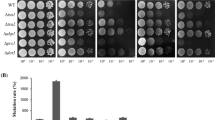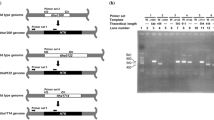Abstract
Peroxiredoxins are antioxidant enzymes that use redox active Cys residues to reduce H2O2 and various organic hydroperoxides to less reactive products, and thereby protect cells against oxidative stress. In yeasts and mammals, the Prx1 proteins are sensitive to hyperoxidation and consequent loss of their peroxidase activity whereas in most bacteria they are not. In this paper we report the characterization of the Prx1 family in the non-parasitic protist Tetrahymena thermophila. In this organism, four genes potentially encoding Prx1 have been identified. In particular, we show that the mitochondrial Prx1 protein (Prx1m) from T. thermophila is relatively robust to hyperoxidation. This is surprising given that T. thermophila is a eukaryote like yeasts and mammals. In addition, the proliferation of the T. thermophila cells was relatively robust to inhibition by H2O2, cumene hydroperoxide and plant natural products that are known to promote the production of H2O2. In the presence of these agents, the abundance of the T. thermophila Prx1m protein was shown to increase. This suggested that the Prx1m protein may be protecting the cells against oxidative stress. There was no evidence for any increase in Prx1m gene expression in the stressed cells. Thus, increasing protein stability rather than increasing gene expression may explain the increasing Prx1m protein abundance we observed.










Similar content being viewed by others
Abbreviations
- Prx:
-
Peroxiredoxin
- Prxs:
-
Peroxiredoxins
- Srx:
-
Sulfiredoxin
References
Gretes MC, Poole LB, Karplus PA (2012) Peroxiredoxins in parasites. Antioxid Redox Signal 17(4):608–633
Wood ZA, Schröder E, Harris JR, Poole LB (2003) Structure, mechanism and regulation of peroxiredoxins. Trends Biochem Sci 28(1):32–40
Rhee SG, Woo HA (2011) Multiple functions of peroxiredoxins: peroxidases, sensors and regulators of the intracellular messenger H2O2, and protein chaperones. Antioxid Redox Signal 15(3):781–794
Wood ZA, Poole LB, Karplus PA (2003) Peroxiredoxin evolution and the regulation of hydrogen peroxide signaling. Science 300(5619):650–653
Biteau B, Labarre J, Toledano MB (2003) ATP-dependent reduction of cysteine-sulphinic acid by S. cerevisiae sulphiredoxin. Nature 425(6961):980–984
Woo HA, Chae HZ, Hwang SC, Yang K-S, Kang SW, Kim K, Rhee SG (2003) Reversing the inactivation of peroxiredoxins caused by cysteine sulfinic acid formation. Science 300(5619):653–656
Rhee SG, Jeong W, Chang TS, Woo HA (2007) Sulfiredoxin, the cysteine sulfinic acid reductase specific to 2-Cys peroxiredoxin: its discovery, mechanism of action, and biological significance. Kidney Int 72:S3–S8
Pascual MB, Mata-Cabana A, Florencio FJ, Lindahl M, Cejudo FJ (2010) Overoxidation of 2-Cys peroxiredoxin in prokaryotes: cyanobacterial 2-Cys peroxiredoxins sensitive to oxidative stress. J Biol Chem 285(45):34485–34492
Notredame C, Higgins DG, Heringa J (2000) T-Coffee: a novel method for fast and accurate multiple sequence alignment. J Mol Biol 302(1):205–217
Darriba D, Taboada GL, Doallo R, Posada D (2011) ProtTest 3: fast selection of best-fit models of protein evolution. Bioinformatics 27(8):1164–1165
Ronquist F, Teslenko M, van der Mark P, Ayres DL, Darling A, Höhna S, Larget B, Liu L, Suchard MA, Huelsenbeck JP (2012) MrBayes 3.2: efficient Bayesian phylogenetic inference and model choice across a large model space. Syst Biol 61(3):539–542
Guindon S, Dufayard JF, Lefort V, Anisimova M, Hordijk W, Gascuel O (2010) New algorithms and methods to estimate maximum-likelihood phylogenies: assessing the performance of PhyML 3.0. Syst Biol 59(3):307–321
Cassidy-Hanley DM (2012) Tetrahymena in the laboratory: strain resources, methods for culture, maintenance, and storage. In: Collins K (ed) Tetrahymena thermophila. Elsevier Academic Press Inc, San Diego, pp 239–276
Cox AG, Winterbourn CC, Hampton MB (2010) Measuring the redox state of cellular peroxiredoxins by immunoblotting. Methods Enzymol 474:51–66
Livak KJ, Schmittgen TD (2001) Analysis of relative gene expression data using real-time quantitative PCR and the 2−ΔΔCT method. Methods 25(4):402–408
Tikhonenkov DV, Janouskovec J, Mylnikov AP, Mikhailov KV, Simdyanov TG, Aleoshin VV, Keeling PJ (2014) Description of Colponema vietnamica sp.n. and Acavomonas peruviana n. gen. n. sp., two new alveolate phyla (Colponemidia nom. nov and Acavomonidia nom. nov.) and their contributions to reconstructing the ancestral state of alveolates and eukaryotes. PLoS One 9(4):e95467
Woo YH, Ansari H, Otto TD, Klinger CM, Kolisko M, Michalek J, Saxena A, Shanmugam D, Tayyrov A, Veluchamy A, Ali S, Bernal A, del Campo J, Cihlar J, Flegontov P, Gornik SG, Hajduskova E, Hora A, Janouskovec J, Katris NJ, Mast FD, Miranda-Saavedra D, Mourier T, Naeem R, Nair M, Panigrahi AK, Rawlings ND, Padron-Regalado E, Ramaprasad A, Samad N, Tomcala A, Wilkes J, Neafsey DE, Doerig C, Bowler C, Keeling PJ, Roos DS, Dacks JB, Templeton TJ, Waller RF, Lukes J, Obornik M, Pain A (2015) Chromerid genomes reveal the evolutionary path from photosynthetic algae to obligate intracellular parasites. Elife 4:e06974
Kwok LY, Schluter D, Clayton C, Soldati D (2004) The antioxidant systems in Toxoplasma gondii and the role of cytosolic catalase in defence against oxidative injury. Mol Microbiol 51(1):47–61
Akerman SE, Müller S (2005) Peroxiredoxin-linked detoxification of hydroperoxides in Toxoplasma gondii. J Biol Chem 280(1):564–570
Clarebout G, Slomianny C, Delcourt P, Leu B, Masset A, Camus D, Dive D (1998) Status of Plasmodium falciparum towards catalase. Br J Haematol 103(1):52–59
Sztajer H, Gamain B, Aumann KD, Slomianny C, Becker K, Brigelius-Flohe R, Flohe L (2001) The putative glutathione peroxidase gene of Plasmodium falciparum codes for a thioredoxin peroxidase. J Biol Chem 276(10):7397–7403
Jortzik E, Becker K (2012) Thioredoxin and glutathione systems in Plasmodium falciparum. Int J Med Microbiol 302(4–5):187–194
Goncalves I, Duret L, Mouchiroud D (2000) Nature and structure of human genes that generate retropseudogenes. Genome 10(5):672–678
Chen C, Gentles AJ, Jurka J, Karlin S (2002) Genes, pseudogenes, and Alu sequence organization across human chromosomes 21 and 22. Proc Natl Acad Sci USA 99(5):2930–2935
Shang Y, Song X, Bowen J, Corstanje R, Gao Y, Gaertig J, Gorovsky MA (2002) A robust inducible-repressible promoter greatly facilitates gene knockouts, conditional expression, and overexpression of homologous and heterologous genes in Tetrahymena thermophila. Proc Natl Acad Sci USA 99(6):3734–3739
Boldrin F, Santovito G, Gaertig J, Wloga D, Cassidy-Hanley D, Clark TG, Piccinni E (2006) Metallothionein gene from Tetrahymena thermophila with a copper-inducible-repressible promoter. Eukaryot Cell 5(2):422–425
Diaz S, Amaro F, Rico D, Campos V, Benitez L, Martin-Gonzales A, Hamilton EP, Orias E, Gutierrez JC (2007) Tetrahymena metallothioneins fall into two discrete subfamilies. PLoS One 2(3):e291
Santovito G, Formigari A, Boldrin F, Piccinni E (2007) Molecular and functional evolution of Tetrahymena metallothioneins: new insights into the gene family of Tetrahymena thermophila. Comp Biochem Physiol C Toxicol Pharmacol 144(4):391–397
Ferro D, Bakiu R, De Pittà C, Boldrin F, Cattalini F, Pucciarelli S, Miceli C, Santovito G (2015) Cu, Zn superoxide dismutases from Tetrahymena thermophila: molecular evolution and gene expression of the first line of antioxidant defenses. Protist 166(1):131–145
Wang X, Wang LK, Wang X, Sun F, Wang CC (2012) Structural insights into the peroxidase activity and inactivation of human peroxiredoxin 4. Biochem J 441:113–118
Sayed AA, Williams DL (2004) Biochemical characterization of 2-Cys peroxiredoxins from Schistosoma mansoni. J Biol Chem 279(25):26159–26166
Koo KH, Lee S, Jeong SY, Kim ET, Kim HJ, Kim K, Song K, Chae HZ (2002) Regulation of thioredoxin peroxidase activity by C-terminal truncation. Arch Biochem Biophys 397(2):312–318
Bolduc JA, Nelson KJ, Haynes AC, Lee J, Reisz JA, Graff AH, Clodfelter JE, Parsonage D, Poole LB, Furdui CM, Lowther WT (2018) Novel hyperoxidation resistance motifs in 2-Cys peroxiredoxins. J Biol Chem 293(30):11901–11912
Randall LM, Manta B, Hugo M, Gil M, Batthyàny C, Trujillo M, Poole LB, Denicola A (2014) Nitration transforms a sensitive peroxiredoxin 2 into a more active and robust peroxidase. J Biol Chem 289(22):15536–15543
Parmigiani RB, Xu WS, Venta-Perez G, Erdjument-Bromage H, Yaneva M, Tempst P, Marks PA (2008) HDAC6 is a specific deacetylase of peroxiredoxins and is involved in redox regulation. PNAS 105(28):9633–9638
Cox AG, Pearson AG, Pullar JM, Jonsson TJ, Lowther WT, Winterbourn CC, Hampton MB (2009) Mitochondrial peroxiredoxin 3 is more resilient to hyperoxidation than cytoplasmic peroxiredoxins. Biochem J 421:51–58
Munday R (2012) Harmful and beneficial effects of organic monosulfides, disulfides, and polysulfides in animals and humans. Chem Res Toxicol 25(1):47–60
Munday R, Munday JS, Munday CM (2003) Comparative effects of mono-, di-, tri-, and tetrasulfides derived from plants of the allium family: redox cycling in vitro and hemolytic activity and phase 2 enzyme induction in vivo. Free Radic Biol Med 34(9):1200–1211
Hu Y, Urig S, Koncarevic S, Wu XJ, Fischer M, Rahlfs S, Mersch-Sundermann V, Becker K (2007) Glutathione- and thioredoxin-related enzymes are modulated by sulfur-containing chemopreventive agents. Biol Chem 388(10):1069–1081
Wu XJ, Kassie F, Mersch-Sundermann V (2005) Induction of apoptosis in tumor cells by naturally occurring sulfur-containing compounds. Mutat Res Rev Mutat Res 589(2):81–102
Jarvis RM, Hughes SM, Ledgerwood EC (2012) Peroxiredoxin 1 functions as a signal peroxidase to receive, transduce, and transmit peroxide signals in mammalian cells. Free Radic Biol Med 53(7):1522–1530
Deponte M (2008) Programmed cell death in protists. Biochim Biophys Acta Mol Cell Res 1783(7):1396–1405
Carson CF, Hammer KA, Riley TV (2006) Melaleuca alternifolia (tea tree) oil: a review of antimicrobial and other medicinal properties. Clin Microbiol Rev 19(1):50–62
Nakayama K, Murata S, Ito H, Iwasaki K, Villareal MO, Zheng YW, Matsui H, Isoda H, Ohkohchi N (2017) Terpinen-4-ol inhibits colorectal cancer growth via reactive oxygen species. Oncol Lett 14(2):2015–2024
Jang HH, Lee KO, Chi YH, Jung BG, Park SK, Park JH, Lee JR, Lee SS, Moon JC, Yun JW, Choi YO, Kim WY, Kang JS, Cheong GW, Yun DJ, Rhee SG, Cho MJ, Lee SY (2004) Two enzymes in one: two yeast peroxiredoxins display oxidative stress-dependent switching from a peroxidase to a molecular chaperone function. Cell 117(5):625–635
Funding
Funding was provided by Flinders University and a PhD scholarship awarded to Sarmad Al-Asadi by the Government of Iraq.
Author information
Authors and Affiliations
Corresponding author
Additional information
Publisher's Note
Springer Nature remains neutral with regard to jurisdictional claims in published maps and institutional affiliations.
Rights and permissions
About this article
Cite this article
Al-Asadi, S., Malik, A., Bakiu, R. et al. Characterization of the peroxiredoxin 1 subfamily from Tetrahymena thermophila. Cell. Mol. Life Sci. 76, 4745–4768 (2019). https://doi.org/10.1007/s00018-019-03131-3
Received:
Revised:
Accepted:
Published:
Issue Date:
DOI: https://doi.org/10.1007/s00018-019-03131-3




